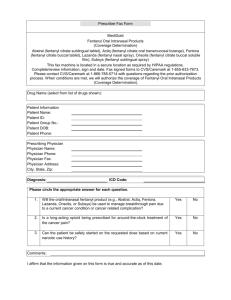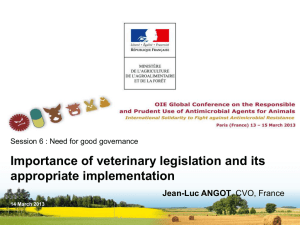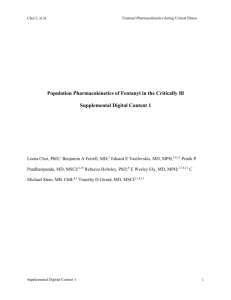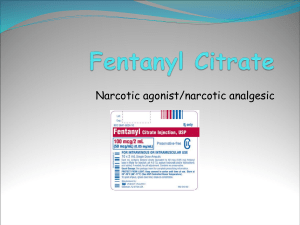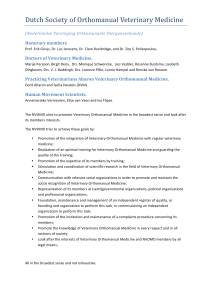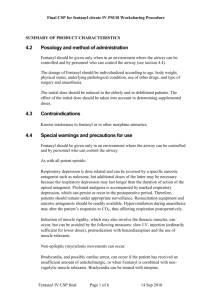summary of product characteristics
advertisement
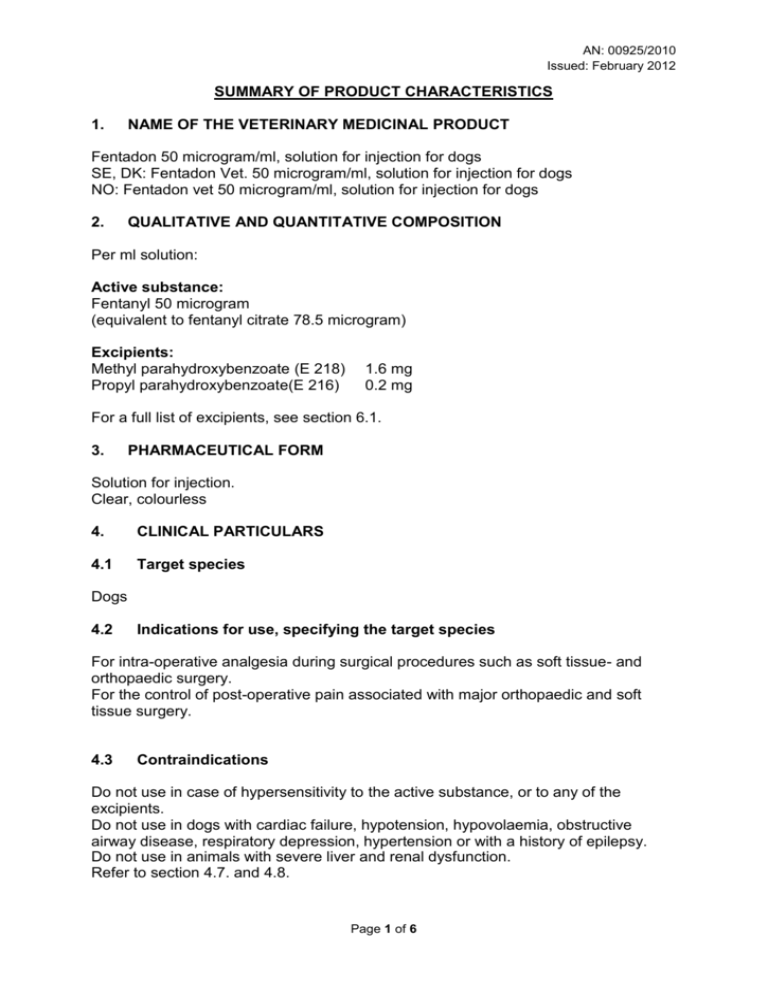
AN: 00925/2010 Issued: February 2012 SUMMARY OF PRODUCT CHARACTERISTICS 1. NAME OF THE VETERINARY MEDICINAL PRODUCT Fentadon 50 microgram/ml, solution for injection for dogs SE, DK: Fentadon Vet. 50 microgram/ml, solution for injection for dogs NO: Fentadon vet 50 microgram/ml, solution for injection for dogs 2. QUALITATIVE AND QUANTITATIVE COMPOSITION Per ml solution: Active substance: Fentanyl 50 microgram (equivalent to fentanyl citrate 78.5 microgram) Excipients: Methyl parahydroxybenzoate (E 218) Propyl parahydroxybenzoate(E 216) 1.6 mg 0.2 mg For a full list of excipients, see section 6.1. 3. PHARMACEUTICAL FORM Solution for injection. Clear, colourless 4. CLINICAL PARTICULARS 4.1 Target species Dogs 4.2 Indications for use, specifying the target species For intra-operative analgesia during surgical procedures such as soft tissue- and orthopaedic surgery. For the control of post-operative pain associated with major orthopaedic and soft tissue surgery. 4.3 Contraindications Do not use in case of hypersensitivity to the active substance, or to any of the excipients. Do not use in dogs with cardiac failure, hypotension, hypovolaemia, obstructive airway disease, respiratory depression, hypertension or with a history of epilepsy. Do not use in animals with severe liver and renal dysfunction. Refer to section 4.7. and 4.8. Page 1 of 6 AN: 00925/2010 Issued: February 2012 4.4 Special warnings The use of this medicinal product must be preceded by a thorough clinical examination. Atropine may be used to block the vagal effects. 4.5 Special precautions for use Special precautions for use in animals This veterinary medicinal product should be individually titrated to an effective dose that provides adequate analgesia and minimises undesirable effects. Animals should be carefully monitored until an effective dose is reached. Due to individual differences in pain sensitivity, the effects of fentanyl may be variable. Older animals may tend to titrate to a lower effective dose than younger animals. It is important when estimating the required dose for intra-operative analgesia to assess the likely degree of surgical stimulation, the effect of premedication drugs, possibility of supportive care like endotracheal intubation and ventilatory support and the duration of the procedure. If other narcotic or CNS-depressant drugs (e.g. propofol, isoflurane, sevoflurane) are used concurrently with fentanyl the dosages of these agents may need to be reduced. When estimating the required dose for post-operative analgesia the degree of tissue damage has to be assessed. As a class, opioids, including this veterinary medicinal product, may result in hypothermia with duration related to dose, bradypnoea, hypotension and bradycardia. Therefore, animals should be continuously monitored for rectal temperature, pulse rate, respiratory rate and heart rhythm during surgical anaesthesia. In case of renal, cardiac or hepatic dysfunction, or hypovolaemia or shock, there may be greater risk associated with the use of the product. It is desirable to reduce dosage in case of hypothyroidism and in case of chronic hepatic or renal disease. As with all narcotic analgesics, care should be taken when administering fentanyl to animals with myasthenia gravis. Facilities for the maintenance of a patent airway, intermittent positive pressure ventilation (IPPV) and oxygen supplementation should be available. When respiratory depression occurs controlled ventilation should be installed. As with all potent opioids, profound analgesia is accompanied by respiratory depression, which may persist into or recur in the early post-operative period. The respiratory depressant effects may be more problematic in animals with pre-existing respiratory disease or increased intracranial pressure. The effect of an opioid on head injury is dependent on the type and severity of the injury and the respiratory support supplied. It is imperative to ensure that adequate spontaneous breathing has been established and maintained before discharge from the recovery area whenever large doses of infusions of fentanyl have been administered. The benefit : risk ratio for using the product should be made by the attending vet. The pharmacological effects of fentanyl citrate can be reversed by naloxone. Special precautions to be taken by the person administering the veterinary medicinal product to animals Fentanyl, an opioid, may cause adverse effects after internal exposure, including respiratory depression or apnoea, sedation, hypotension and coma. The product may cause hypersensitivity reactions. Page 2 of 6 AN: 00925/2010 Issued: February 2012 Avoid contact with the skin and eyes. Wear protective gloves when handling the product. Wash hands after use. Wash any splashes from skin and eyes immediately with large amounts of water. Remove contaminated clothes. Care should be taken to avoid accidental self-injection. In case of accidental selfinjection, seek medical advice immediately and show the package leaflet to the doctor but DO NOT DRIVE as sedation may occur. Adverse effects on the foetus cannot be excluded. Pregnant women should avoid handling the product. In case of breastfeeding women being accidentally exposed, breastfeeding is discouraged for 24 hours, as fentanyl may transfer to breast milk. ADVICE TO DOCTORS: Fentanyl is an opioid whose toxicity may cause clinical effects including respiratory depression or apnoea, sedation, hypotension and coma. When respiratory depression occurs controlled ventilation should be installed. Administration of the opioid antagonist naloxone to reverse the symptoms is recommended. 4.6 Adverse reactions (frequency and seriousness) In common with other narcotic analgesics, the most common serious adverse reactions with fentanyl are respiratory depression and bradycardia. Bradycardia may occur due to increased cardiac vagal stimulation. The respiratory depressant effects can be of long duration and may exhibit a biphasic pattern. A transient fall in blood pressure may occur following intravenous administration of fentanyl citrate injection even at doses of 2.5 - 5 µg/kg. Hypothermia may occur. Lowered nociceptive threshold in dogs when the effects of drug dissipate have been described. During studies with the product the following reactions have been observed: Rapid breathing, panting, urination, defecation, vocalisation, tongue protruding, overactivity, irritability, body tremors, vomiting, scratching and sedation. 4.7 Use during pregnancy, lactation or lay Laboratory studies in rats have not produced any evidence of a teratogenic, foetotoxic, mutagenic effects. Placental transfer of fentanyl occurs. Administration during parturition may cause respiratory depression in the foetus. The safety of the veterinary medicinal product in the target species has not been established during pregnancy and lactation. The use of the product is not recommended during pregnancy. 4.8 Interaction with other medicinal products and other forms of interaction Fentanyl is a potent anaesthetic sparing substance. To avoid anaesthetic overdose in dogs treated with the veterinary medicinal product, anaesthetic agents should be administered until the desired effect is produced. The veterinary medicinal product should be used with caution in conjunction with morphine or other opioid type analgesics as the effects have not been studied. The effects of the concomitant use of the veterinary medicinal product and αadrenergic agonists have not been studied. Therefore, α2-adrenergic agonists should Page 3 of 6 AN: 00925/2010 Issued: February 2012 be used with caution in animals dosed with the veterinary medicinal product due to potentially additive or synergistic effects. 4.9 Amounts to be administered and administration route For intravenous administration. Onset of action is seen within 5 minutes. The duration of the analgesic effect is 20 (lowest recommended dose) to 40 minutes (highest recommended dose). Fentanyl can be administered according to the following dosage regimen: Analgesia by Continuous Rate Infusion (CRI) 5 – 10 µg/kg (0.1 -0.2 ml/kg) IV as a bolus, followed by 12 – 24 µg/kg/hr (0.24 – 0.48 ml/kg/hr) IV for intra-operative analgesia as CRI. 6 – 10 µg/kg/hr (0.12 – 0.2 ml/kg/hr) IV for subsequent post-operative analgesia as CRI in sedated animals. During post-operative CRI administration of fentanyl, animals should be monitored carefully. Chemical-physical compatibility has only been demonstrated for dilutions 1:5 with the following solutions for infusion: sodium chloride 0.9%, Ringer solution, and glucose 5%. The veterinary medicinal product has a narrow margin of safety and it is important to measure the dose accurately to avoid over-dosing. 4.10 Overdose (symptoms, emergency procedures, antidotes), if necessary A 2 fold overdose as a bolus injection resulted in the effects mentioned in section 4.6. In the event that any of the following observations are made following the application/overdose of the product, reversal should be initiated: severe sedation, unconsciousness, seizures, laboured or abdominal breathing or severe hypotension. The specific narcotic antagonist naloxone hydrochloride can be used to counteract respiratory depression. A dose of 0.01 to 0.04 mg/kg is given intravenously and may be repeated at intervals of 2 to 3 minutes if necessary. 4.11 Withdrawal period(s) Not applicable. 5. PHARMACOLOGICAL PROPERTIES Pharmacotherapeutic group: Analgesics. Opioids. Phenylpiperidine derivatives, ATCvet code: QN02AB03. 5.1 Pharmacodynamic properties Fentanyl is a synthetic opioid that is selective for the µ-opioid receptor. Fentanyl citrate has the ability to produce profound analgesia. It causes only minor heart and circulatory depression. Page 4 of 6 AN: 00925/2010 Issued: February 2012 The principal actions of therapeutic value are analgesia and sedation. Following intravenous injection fentanyl has rapid onset of action, although the maximal analgesic and respiratory depressant effect may not occur for several minutes. 5.2 Pharmacokinetic particulars After intravenous injection the fentanyl plasma concentrations decrease rapidly primarily due to redistribution. In dogs fentanyl is 60 % bound to plasma proteins. Fentanyl has a large volume of distribution of more than 5 l/kg. The plasma kinetics of fentanyl are independent of the dose in the range of recommended doses. Fentanyl has a relatively long elimination half-life: 45 min to more than 3 hours in dogs. The clearance is high about 40 to 80 ml/min/kg. It is primarily eliminated by metabolism, with hydroxylation and dealkylation being the primary mechanisms, and less than 8% of the total dose is eliminated as unchanged drug. In addition to hepatic metabolism fentanyl may be metabolized in extra hepatic sites and eliminated by extra renal routes. 6. PHARMACEUTICAL PARTICULARS 6.1 List of excipients Methyl parahydroxybenzoate (E 218) Propyl parahydroxybenzoate (E 216) Sodium chloride Hydrochloric acid (for pH-adjustment) Sodium hydroxide (for pH-adjustment) Water for injection 6.2 Incompatibilities Do not mix with any other veterinary medicinal product except the infusion solutions indicated in section 4.9. The product is incompatible with injection fluids containing meloxicam or any other nonaqueous solution. 6.3 Shelf life Shelf-life of the veterinary medicinal product as packaged for sale: 3 years Shelf-life after first opening the immediate packaging: 28 days Chemical and physical stability of the dilutions (as indicated in section 4.9) has been demonstrated for 4 hours at 25°C. From microbiological point of view the dilutions should be used immediately. 6.4. Special precautions for storage Do not freeze Page 5 of 6 AN: 00925/2010 Issued: February 2012 6.5 Nature and composition of immediate packaging Vials of uncoloured glass type I, filled with 5, 10, 20, 25, 30, 50 and 100 ml Teflon coated chlorobutyl rubber stoppers type I (the stoppers are secured with aluminium caps) Not all pack sizes may be marketed. 6.6 Special precautions for the disposal of unused veterinary medicinal product or waste materials derived from the use of such products Any unused veterinary medicinal product or waste materials derived from such veterinary medicinal product should be disposed of in accordance with local requirements. 7. MARKETING AUTHORISATION HOLDER Eurovet Animal Health B.V. Handelsweg 25, PO Box 179, 5531 AE Bladel The Netherlands 8. MARKETING AUTHORISATION NUMBER Vm 16849/4031 9. DATE OF FIRST AUTHORISATION 27 February 2012 10 DATE OF REVISION OF THE TEXT February 2012 PROHIBITION OF SALE, SUPPLY AND/OR USE Controlled drug Administration only by a veterinary surgeon. Veterinary product on restricted prescription. To be supplied only on veterinary prescription. Page 6 of 6
